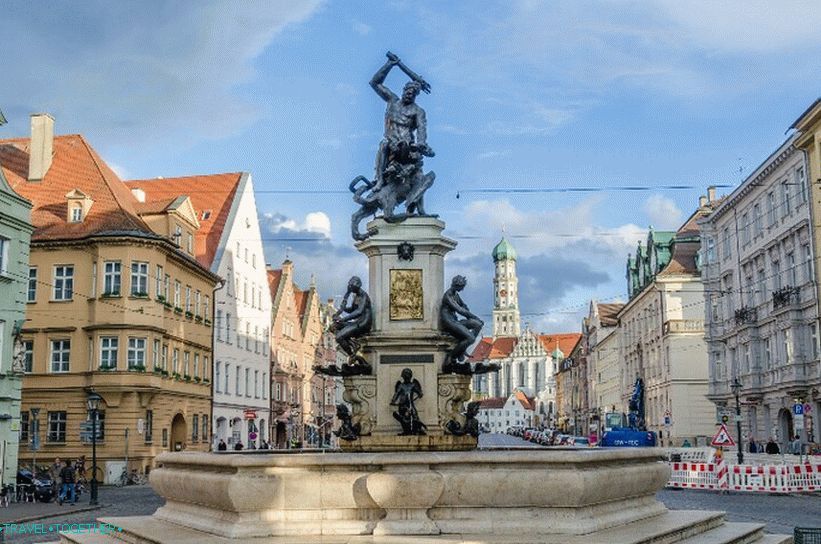Augsburg (Germany) – detailed information about the city from a photo. The main attractions of Augsburg with a description, guides and maps.
Contents
City Augsburg (Germany)
Augsburg – a city in southern Germany, the capital of the historical area Swabia. It is one of the oldest cities in the country and the oldest city of bavaria. Augsburg – a city with a rich historical heritage, a major university and tourist center.
The city is located in the southwestern part of Bavaria on the rivers Lech, Vertah and Zingold. Therefore, Augsburg is sometimes called city of “three rivers”. The city lies at the foot of the northern foothills and the hills of Friedberg. Nearby is a large forest – Augsburg National Park. The climate is temperate. Because of its location on the border between sea climate and dry Continental weather is often quite unstable. Per year about 800 mm of precipitation falls. Summer is warm, but not hot. Winter relatively mild with slight frosts.
 Panorama of Augsburg
Panorama of Augsburg
- Practical information
- Story
- How to get there
- sights
- Video
- Maps and guides
- Comments and reviews
Practical information
- The population is almost 290,000 inhabitants. For this indicator, Augsburg is the third city in Bavaria, second only to Munich and Nuremberg.
- Area – 147 km2
- The language is German.
- Currency – Euro.
- Visa – Schengen.
- Time – Central European UTC +1, in summer +2.
- Augsburg is famous for its plum cake and sausages.
- Despite its antiquity, Augsburg is a youth city. There are many students, pubs, restaurants and shops, most of which located in the old town. There is a large shopping center – City Galerie.
Story
Augsburg is one of the oldest cities in Germany, founded the Romans in the 15th century BC. The heyday of the city fell on Middle Ages. At this time, Augsburg had the status of not only free imperial city, but also one of the main trading cities of Europe. The rich history has left a vast legacy: beautiful historic buildings, magnificent cathedrals and parts of old urban fortifications.
Augsburg was founded as a legionnaire camp, but by the 1st century had become center of the Roman province. In the early Middle Ages during of the reign of Charlemagne the city suffered in several battles between Bavaria and Franconia. In 1156 under Frederick Barbarosse Augsburg received city rights, and in 1276 the rights of free imperial cities.
 Old city Augsburg
Old city Augsburg
Due to the location at the intersection of important trade routes Augsburg grew rapidly and grew rich. The status of one of the main trading cities of Europe he kept from the late Middle Ages until the end of the era Renaissance. Watts time of the Thirty Years War was located here. garrison of the Bavarian troops. After the Napoleonic Wars Augsburg lost the privileges of the free imperial city and was annexed to Bavarian kingdom. In the 19th century, the city was a large industrial the center of Bavaria.
The Second World War did not bypass Augsburg. City subjected to intense bombardment by the Anglo-American aircraft, which significantly damaged the historic center.
How to get there
The nearest major airport is in Munich. Get out Munich to Augsburg can be less than an hour by train. Trains depart from the main train station. Tickets available buy at special ticket machines that allow profitable travel around Bavaria on regional trains.
Another option is Stuttgart Airport. From Stuttgart and Augsburg can also be reached by train.
 Christmas market in Augsburg
Christmas market in Augsburg
Augsburg has a regular train service to many major cities of Bavaria and Germany. Also the city has an excellent car accessibility (A8 motorway). Public transport is represented by five tram lines and by buses.
sights
The most interesting sights of Augsburg.
 Town Hall on market square
Town Hall on market square
The Town Hall is a majestic historical building that is one of the main attractions and symbol of Augsburg. Town Hall was built in the 20s of the 17th century. Considered one of the most beautiful secular Renaissance style buildings located north of the Alps. Town Hall is open to the public from 10.00 to 18.00.
 Perlachturm Tower
Perlachturm Tower
Perlachturm is a 70-meter high tower located not far from from the town hall. The first tower on the site of the ancient Roman amphitheater was built in the 10th century and was a sentinel. Perlachturm was rebuilt Elias Hollem at the beginning of the 17th century under the style of a new town hall. With The observation deck offers stunning views of the historic center of Augsburg.
 Fuggeria
Fuggeria
Fuggeria is the world’s oldest social settlement, built in first half of the 16th century for impoverished citizens and containing more 60 houses.
 Cathedral of sv. Mary’s
Cathedral of sv. Mary’s
Cathedral of sv. Mary – the grandiose gothic franciscan church and one of the most beautiful medieval sights Augsburg. The cathedral was built in the 11th century on the site of an old building. Carolingian church. Cathedral of sv. Mary is the church of the romano-gothic style with two portals saturated figures, with the world’s oldest cycle of painting on glass, Romanesque crypt, wall murals and a bishop’s gallery, altar paintings Hans Holbein the Elder and masterfully the work of George Petels – Christ figure “Ecce-Homo”. In addition, here you can see hundreds complex ancient tombstones.
 Hercules Fountain
Hercules Fountain
On Maximilianstraße you can discover three unique historical fountain, depicting Hercules, Augustus and Mercury. Fountains were built in 1600.
 Cathedral of sv. Annas
Cathedral of sv. Annas
Cathedral of sv. Anne – an old baroque church founded in 14 century by the Carmelite monks. The church includes two chapels. The Fugger Chapel and its tomb is the very first structure in Renaissance style in all of Bavaria.
 Basilica of sv. Ulrich
Basilica of sv. Ulrich
Basilica of sv. Ulrich and Afra – beautiful late gothic sacral structure, founded in the 15th century on the territory Benedictine monastery. The basilica was completed at the beginning of 17 century. This Protestant church is the second largest religious building of Augsburg.
 Old cistercian monastery
Old cistercian monastery
The old Cistercian monastery was founded at the beginning of the 13th century and functioned until the beginning of the 19th century. Now here is the Swabian gallery, museum and park.
 Plumbing in Red Gate
Plumbing in Red Gate
Plumbing in the Red Gate – a historic ensemble, built in the first half of the 15th century. Contained three water pressure towers that fed the old city until 1876.
 Church of sv. Moritz
Church of sv. Moritz
Church of sv. Moritz is one of the oldest religious buildings. Augsburg and Bavaria. The church was founded in the 11th century. In the 13th century the building after the fire was rebuilt in the Gothic style, and later in Renaissance style.
What else to see in Augsburg:
- Arsenal – a historic building built on the site of the old granaries in the 17th century. This fortified structure was used. as an armory and built in the Renaissance style. Here now The Roman Heritage Museum of Augsburg and its neighborhoods.
- Mozart’s House – the old baroque house of the father of genius composer.
- Maximilian Museum – Interesting Expositions Related to history and culture of the city and region.
- The synagogue is a sacred Judaic structure built in early 5th century.
- Wieselhaus – one of the last surviving Renaissance buildings of Augsburg. Now here is the Fugger Museum and Welsuer
- The Butchers Building is a historic late style building. renaissance.
Video
Maps and guides
Tourist Map of the City Map of Augsburg Travel Guide Augsburg in Russian






